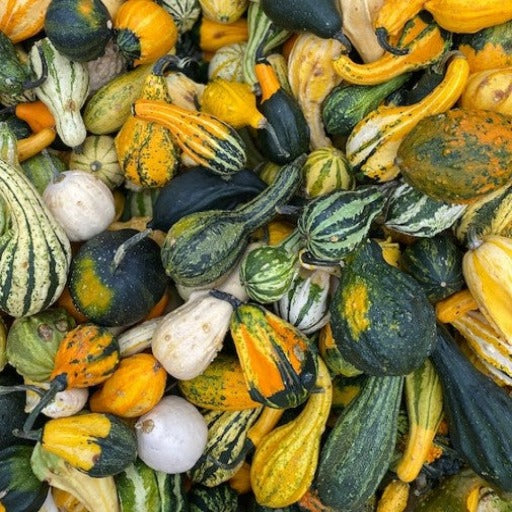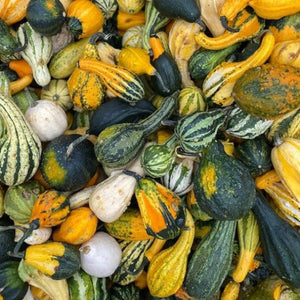- Hardiness Zone: 2-12 Annual
Seed Depth: 1 inch
Seed Spacing: 18–24 inches
Row Spacing: 6–8 feet
Sunlight: Full sun
Days to Sprout: 7–10 days
Days to Maturity: 95–120 days
Growth Habit: Sprawling vine
Sunlight: Requires full sun, with at least 6–8 hours of direct sunlight daily for optimal growth.
Soil Type: Prefers well-drained, fertile soil with a pH of 6.0–7.5. Enrich soil with compost or organic matter before planting.
When to Plant: Sow seeds directly outdoors after the last frost, when soil temperatures reach 70°F or higher.
Direct Sowing: Plant seeds 1 inch deep, spacing them 18–24 inches apart in rows 6–8 feet apart or in hills with 2–3 seeds per hill. Thin to the strongest seedling per hill.
Indoor Sowing: Start seeds indoors 2–3 weeks before the last frost and transplant carefully to avoid root disturbance.
Succession Planting: Not typically needed; gourds produce a single harvest.
Watering: Water deeply and consistently, keeping the soil evenly moist but not soggy. Reduce watering as fruit matures.
Fertilizing: Apply a balanced fertilizer at planting and switch to a phosphorus-rich fertilizer as vines begin to flower.
Pruning: Trim excessive vines to focus energy on fruit development.
Pest and Disease Control: Watch for squash bugs, vine borers, and powdery mildew. Use row covers or organic solutions if needed.
When to Harvest: Harvest when the gourds are fully mature, hard, and vibrant in color, typically 95–120 days after planting. The stem should be dry and woody.
How to Harvest: Cut gourds from the vine with a sharp knife, leaving 1–2 inches of stem attached for longer storage. Handle carefully to avoid bruising.
Seed Collection: Scoop seeds from fully ripened gourds, rinse, and dry thoroughly.
Storing Seeds: Store seeds in an airtight container in a cool, dry place.
Why You’ll Love It
Small Mix Gourds are a fun and festive way to bring personality to your fall garden. This heirloom blend produces a colorful mix of warted, smooth, striped, and uniquely shaped gourds — all compact and perfect for crafting, decorating, or using as natural centerpieces. Easy to grow and productive, these vines are ideal for fences, trellises, or garden beds and are always a hit with kids and seasonal gardeners alike.
Plant Characteristics
Height: Low-growing vine
Growth Habit: Spreading or climbing vines up to 10 feet
Fruit Type: Small ornamental gourds in various colors, shapes, and textures
Days to Maturity: 90–110 days
Hardiness: Warm-season annual
Flavor and Culinary Uses
Flavor: Not edible — grown strictly for ornamental use
Culinary Uses: None — for decoration only
Companion Planting Tips
Good Companions: Corn, sunflowers, beans, and nasturtiums
Avoid Planting Near: Other gourds or squash varieties if you want to avoid cross-pollination
Bonus Benefit: Perfect for trellising or letting sprawl in open garden areas for natural weed suppression and stunning fall harvest displays
Common Issues and Solutions
Powdery Mildew: Improve airflow and water early at the base to prevent fungal growth
Poor Pollination: Encourage bees with nearby flowers or hand-pollinate early in the morning
Rotting Gourds: Harvest before heavy frost and cure in a dry, shaded area to ensure long-lasting decorations
Seeds Per Packet
| 1g | Approximately 17 |
| 3g | Approximately 51 |
| 5g | Approximately 85 |
| 7g | Approximately 121 |
Why You’ll Love It
Small Mix Gourds are a fun and festive way to bring personality to your fall garden. This heirloom blend produces a colorful mix of warted, smooth, striped, and uniquely shaped gourds — all compact and perfect for crafting, decorating, or using as natural centerpieces. Easy to grow and productive, these vines are ideal for fences, trellises, or garden beds and are always a hit with kids and seasonal gardeners alike.
Plant Characteristics
Height: Low-growing vine
Growth Habit: Spreading or climbing vines up to 10 feet
Fruit Type: Small ornamental gourds in various colors, shapes, and textures
Days to Maturity: 90–110 days
Hardiness: Warm-season annual
Flavor and Culinary Uses
Flavor: Not edible — grown strictly for ornamental use
Culinary Uses: None — for decoration only
Companion Planting Tips
Good Companions: Corn, sunflowers, beans, and nasturtiums
Avoid Planting Near: Other gourds or squash varieties if you want to avoid cross-pollination
Bonus Benefit: Perfect for trellising or letting sprawl in open garden areas for natural weed suppression and stunning fall harvest displays
Common Issues and Solutions
Powdery Mildew: Improve airflow and water early at the base to prevent fungal growth
Poor Pollination: Encourage bees with nearby flowers or hand-pollinate early in the morning
Rotting Gourds: Harvest before heavy frost and cure in a dry, shaded area to ensure long-lasting decorations
Seeds Per Packet
| 1g | Approximately 17 |
| 3g | Approximately 51 |
| 5g | Approximately 85 |
| 7g | Approximately 121 |






Share and get 15% off!
Simply share this product on one of the following social networks and you will unlock 15% off!